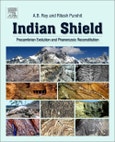Indian Shield: Precambrian Evolution and Phanerozoic Reconstitution highlights unique evolutionary trends covering a period of over 3,500 million years, from the oldest crust to the most recent geological activity of the Indian Subcontinent. The book discusses regional terrain geology in terms of the evolutionary history of the crust, describing how the Precambrian Shield evolved from a stable continental region to a tectonically unstable zone marked by frequent high-intensity earthquakes in a Plate-interior setting. It is a complete and readable account of the history of growth and evolution of the Indian Subcontinent, including Bangladesh, Bhutan, India, Nepal and Pakistan.
The book is intended for graduate students, researchers, and teachers in the geosciences, especially geophysics, geomorphology and geology. The book also serves as an important resource for tectonics and petrology researchers, as well as those involved in exploration of mineral resources.
Please Note: This is an On Demand product, delivery may take up to 11 working days after payment has been received.
Table of Contents
PART 1: Precambrian Crust of India: A general Introduction 1. Pristine size, shape and tectonic framework of Indian Shield 2. Geomorphotectonic and Geophysical characterization of Indian Subcontinent 3. Framework of Indian Shield: Concepts and tectonic subdivisions 4. Geology and evolutionary history of Precambrian crustal blocks 5. Correlation and evolutionary history of the Indian Shield
PART 2: Early Phanerozioc Geology of India 6. Palaeozoicgeologic history 7. Geology of the Gondwana Supergroup: 1. Definition, Classification, and Distribution 8. Geology of the Gondwana Supergroup: 2. Sedimentation, Basin Morphology and Evolution
PART 3: Between Jurassic Breakup and the Himalayan Collision 9. Jurassic marine incursions and basin evolution 10. Development of fracture system (Lineament) consequent on break-up of Gondwanaland 11. Plume outbursts and their manifestations on Indian Shield
PART 4: Geology and Evolution of the Himalayas 12. Constituents and Tectonic architecture of the Himalayas 13. Lithotectonic Units and Sedimentation pattern 14. Pattern of metamorphism and Tectonichistory of the Himalayas
PART 5: Quaternary Geology and Active tectonics and Palaeoseismicity 15. Quaternary Basin evolutions and sedimentation pattern 16. Active tectonics and resultant seismicity in Indian Subcontinent







